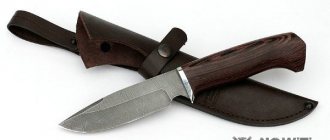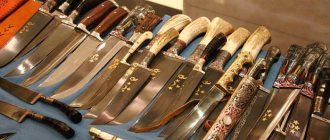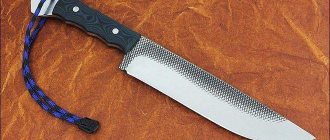The worship of weapons, his elevation to the rank of god and wizard at the same time, knighting, the passing of a couple under lowered swords at marriage - all this is the medieval understanding of the sword as a symbol of honor and glory. Swords then had their own names and were used only for their intended purpose. Cults and rituals of weapons, both before and now, are characteristic of a wide variety of peoples who inhabited all continents from antiquity to the invention of firearms. For many centuries, swords, sabers, swords, knives, etc. dominated the Earth.
Guard - part of a bladed weapon
The guard has been used on knives and sabers for a very long time. This element was known even to the ancient Romans. Gunsmiths forged guards of various shapes and sizes. Each bladed weapon has a hilt and a blade.
And the separator of these main parts is the guard. She protected her hand from the enemy's blade.
It was made in the form of convex shields or an arch near the sword handle. Translated from French, garde means security. Initially it was made in the form of a flat bar.
A little later they began to make it in the form of a small disk. Starting from the 16th century, the guard began to be made round or convex. Then it becomes a full-fledged hand protection and covers the entire hand. Over time, the types and decor of the guard changed many times.
What is a guard on a knife
A blade with a clearly defined guard.
Almost all modern knives have this element. A guard is one of the signs of a bladed weapon if its edges protrude more than 5 mm. But it is necessary to take into account such factors as the length of the blade and its thickness in the butt.
An example would be a knife with a developed guard and grooves for fingers on the handle, but the length of the blade will be less than 90 mm. Such a product will not be classified as a bladed weapon. You should also take into account various requirements from GOST No. 51644-2000 and GOST No. R 51500-99.
Maybe the best option would be a knife model with a removable guard. Such a product can be transformed from a bladed weapon into a household accessory in a matter of seconds. A knife without a guard can be carried with you without complaints from law enforcement agencies.
Types of European swords
The length of the handle determines whether the sword can be held with one hand or two. Based on the number of grips, this weapon is divided into the following types:
- One-handed is a light weapon, its weight ranges from 700 grams to 1.5 kg. As a rule, this is a short sword.
- The one-and-a-half-handed one is heavier than the previous one and longer. The length of the handle is not enough to freely grab the weapon with both hands. The blade is long.
- The two-handed one has a lot of weight, it ranges from 3.5 to 6 kg, and the length reaches up to 140 cm.
Another classification is also familiar. It is based on the length of the blade:
- the short one has a blade from 60 to 70 cm and is used for close combat;
- the long one has a blade of 90 cm;
- cavalry is made with a blade more than 90 cm, as it is used by a horseman, including against a foot enemy.
Both classifications are related. It is logical that a long sword will weigh more and will have to be held with both hands.
Guard typology
The handle and its pommel with a guard make up the hilt of a bladed weapon. It can be open, when only the cross guard protects the fingers, or it can be closed. In the second option, one or more arches are connected to the pommel to protect the fingers.
The arms may be shorter than the length of the handle; such a hilt is a semi-open version. Closed or semi-open, called complex or developed. The head on the pommel serves as a counterweight, which improves the balance of the weapon.
It is made from heavy metals such as lead. It helps to hold the handle and prevents the hand from slipping under the influence of centrifugal force while swinging the sword.
The guards on such products came in various shapes, and they were a decoration of the weapon.
They were very diverse: a simple crosshair, in the form of petals and a basket. The guard has found application both on long-bladed weapons and on knives and daggers. This element may only be absent on a special or construction tool.
Examples of knives with guards.
Hilt and handle
An ancient sword with a decorated guard.
The hilt is the part of the hilt by which the sword is held. The hilt ends with a pommel or headband. It is also called an apple due to its similar shape. The guard and pommel can be used to deliver crushing and stunning blows in close combat. On expensive swords, often ceremonial rather than combat, the hilts were decorated with patterns and precious stones.
The handle should be comfortable to grip; this determines how well you can fencing with a sword.
Therefore, you need to buy a sword in a place where you can try it out. Pick it up, understand balancing, try a few fencing and slashing techniques.
Tsuba - Japanese guard
Swords and combat knives are of Japanese origin, mounted using small tsubas. They differ from the European versions only in their sizes. The Japanese have never protected their hands with any structures such as European arches or cups.
For the tradition of tanto-jutsu and ken-jutsu, the principle of delivering weapons under attack is generally unacceptable, as happens in European fencing. The technique of using Japanese weapons does not provide for a long exchange of attacks.
The battle was resolved with almost a single first blow. For this reason, closed large guards are meaningless. A small steel or bronze tsuba disk, which extends just a little beyond the boundaries of the handle, is quite sufficient.
Tsuba gives Japanese weapons a special status. In the homeland of this small element, there are special schools for its production and installation. The Japanese know how to find beauty in the completely ordinary.
Tsuba on a Japanese tanto blade.
How to make a guard with your own hands
There are many people who make their own knives. In this way, the master receives a product that will exactly meet his requirements. But the guard is usually purchased separately, since its manufacture takes a lot of time.
They are made from various materials: brass, cupronickel, steel, bronze and silver. If you decide to make a guard yourself, then you should make it spectacular so that the finished cast blank looks attractive. Your actions should be as follows:
- Having a small workpiece on hand, you need to cut a narrow hole in it to attach the blade. To do this, use a drill with a small drill bit. Please note that the drill must be thinner than the thickness of the blade. Along a pre-drawn line, it is necessary to drill a series of holes and remove the jumpers between them. For this you will need a needle file. After this, you can process the guard to the required size.
- Next, you should hammer the guard onto the blade. Fix the blade in a vice and attach the guard. Use a small hammer or any available tool for this. To prevent dents from leaving on the metal, you can place a piece of fabric.
- To prevent moisture from getting between the blade and the guard, use epoxy resin or quick glue. You should thoroughly coat the joint with the compound and remove the excess with a rag. Once the process is complete, you can work on the knife handle.
step-by-step production of a guard.
Garda and the law
Guards on blades appeared a very long time ago. She protected her hand, blocking enemy weapons. And it made it possible to quickly remove the knife from the body of a defeated opponent. Today, the guard is present on almost all products in the knife industry.
But it should be remembered that the presence of such a limiter is a sign of a cold weapon. Because this element of the blade allows you to conveniently strike in a wide variety of directions. But in accordance with the law, the length of the blade and its thickness also matter.
Knives that have a finger groove in the handle and a developed guard must have a blade thickness of no more than 2.5 mm at the spine or the blade length must be less than 90 mm. The hand limiter should not exceed 5 mm, otherwise it is a sign of a bladed weapon.
The provisions of GOST 51644-2000 indicate the acceptable designs and sizes of knives for cutting and removing skins. It says that the blade thickness in the butt is allowed up to 2.4 mm with blade parameters up to 150 mm. If the product has finger grooves and a developed guard.
According to GOST rules for tourist knives, products with a spine of up to 3.5 mm must not have a guard or grooves for fingers on the handle. Study Russian legislation carefully to avoid getting into an unpleasant situation.
Shape and device of the sword
There is an opinion that the blade of a sword can be straight or curved. To understand the issue, the wording from official sources is considered. GOST R 51215-98 shows that only contact weapons, piercing and chopping, with a blade that can be considered a sword:
- straight;
Katana is a samurai sword. - massive;
- long or medium;
- has two blades.
From the definition it is clear that if the blade deviates from the straight shape and is sharpened on both sides, the weapon can no longer be considered a sword.
This is not a one-sided opinion of the Russian standard. The Japanese also distinguish between a sword and a katana; it is classified as a two-handed saber. There are two main parts of this weapon:
- blade;
- hilt.
The blade of a sword is its combat piercing and cutting part, measuring from 60 cm. Considering this part, we distinguish:
- Blade , used for both cutting and chopping actions. It was not sharpened to a razor sharpness; such a blade would break if it hit the armor or shield. But the sharpness was enough to cut the enemy or cut off his limbs. Double-sided sharpening makes it possible to cause damage when moving backwards.
- The fuller is made to improve the rigidity of the blade structure. It becomes stronger for side loads and the weight of the weapon is reduced.
- The point is used for stabbing. They can hit the joints of armor if the enemy is wearing armor.
- Ricasso is the part of the blade adjacent to the handle and not sharpened. This part makes it possible to make the handle shorter. This handle provides good control of the blade when stabbing.
As can be seen from the description, the hilt is also an important element, and if it is made correctly, the sword becomes obedient.
The hilt on the sword also has components, each with its own functions:
- Handle. Sword guard.
- pommel
- Garda.
We will analyze each part of the hilt separately and in more detail.











